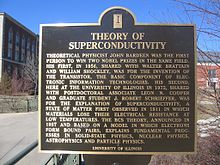
Back نظرية بي سي أس Arabic বিসিএস তত্ত্ব Bengali/Bangla Teoria BCS Catalan BCS-Theorie German Teoría BCS Spanish BCS-teooria Estonian نظریه بیسیاس Persian BCS-teoria Finnish Théorie BCS French Teoiric BCS Irish

In physics, the Bardeen–Cooper–Schrieffer (BCS) theory (named after John Bardeen, Leon Cooper, and John Robert Schrieffer) is the first microscopic theory of superconductivity since Heike Kamerlingh Onnes's 1911 discovery. The theory describes superconductivity as a microscopic effect caused by a condensation of Cooper pairs. The theory is also used in nuclear physics to describe the pairing interaction between nucleons in an atomic nucleus.
It was proposed by Bardeen, Cooper, and Schrieffer in 1957; they received the Nobel Prize in Physics for this theory in 1972.
© MMXXIII Rich X Search. We shall prevail. All rights reserved. Rich X Search